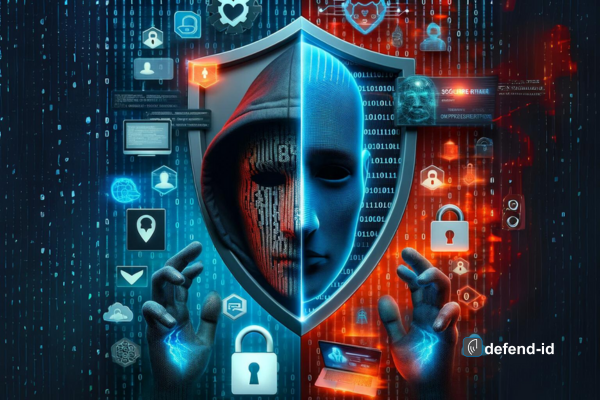In today’s hyperconnected world, technology has become an indispensable part of our lives, seamlessly weaving its way into our daily routines. From online banking and shopping to social media interactions and entertainment, technology has revolutionized the way we communicate, work, and engage with the world around us. However, this interconnectedness also brings with it a heightened risk to our personal information, making us vulnerable to identity theft. Identity theft protection in the digital age is something we all should be aware of.
The Double-Edged Sword of Technology: A Balancing Act of Protection and Exposure
Technology plays a dual role in our identity protection: it both shields and exposes our personal information. On the one hand, secure online banking platforms, encrypted communication channels, and password authentication mechanisms help safeguard our financial and sensitive data. Social media platforms, while not entirely secure, allow us to connect with friends and family, share experiences, and stay informed.
However, this same technology can also be exploited by cybercriminals to steal our identities. Phishing scams, malicious software, and data breaches are just a few examples of how criminals capitalize on the convenience and ubiquity of technology to infiltrate our digital lives.
The Evolving Landscape of Identity Theft: Staying Ahead of the Curve
 The methods used by identity thieves are constantly evolving, adapting to advancements in technology and our changing online habits. Phishing scams, once relying on deceptive emails, have become more sophisticated, impersonating legitimate websites and using social engineering techniques to trick users into revealing personal information.
The methods used by identity thieves are constantly evolving, adapting to advancements in technology and our changing online habits. Phishing scams, once relying on deceptive emails, have become more sophisticated, impersonating legitimate websites and using social engineering techniques to trick users into revealing personal information.
Malware attacks, which can infect our devices through malicious links or attachments, can steal data, install spyware, and even lock us out of our devices, demanding ransom payments. Data breaches, often caused by inadequate security measures or human error, can expose millions of personal records, leaving individuals vulnerable to identity theft.
Advanced Identity Theft Prevention Technologies: Leveraging Technology for Your Protection
Fortunately, technological advancements also offer solutions for mitigating identity theft risks. Facial recognition software, when implemented securely, can verify identities and reduce the likelihood of impersonation. Data encryption scrambles sensitive information, making it unreadable to unauthorized individuals. Tokenization replaces sensitive data with unique identifiers, further protecting it from theft.
Practical Tips for Navigating the Digital Labyrinth: Strategies to Safeguard Your Identity
In the digital age, vigilance and proactive measures are essential for protecting our identities. Here are some practical tips to navigate the online world safely:
- Be selective about personal information shared online. Avoid sharing sensitive information like your Social Security number, birth date, or financial account details on social media platforms or public forums.
- Create strong and unique passwords for all your online accounts. Avoid using easily guessable information like birthdays or common words. Consider using a password manager to securely store and manage your passwords.
- Enable multi-factor authentication (MFA) on all your important accounts. MFA adds an extra layer of security by requiring a verification code from your mobile device or email in addition to your password.
- Regularly update your security software and operating systems. Security patches and updates address vulnerabilities that hackers can exploit.
- Be cautious of suspicious emails, links, and attachments. Phishing scams often use these tactics to trick you into revealing personal information or clicking on malicious links.
- Regularly conduct cybersecurity audits of your devices and accounts. Check for unusual activity, suspicious login attempts, or unauthorized charges.
The Emotional Impact of Identity Theft – (The Emotional Toll of Identity Theft)
Identity theft can have a devastating impact on individuals, not just financially, but also emotionally and psychologically. The stress, anxiety, and fear associated with identity theft can lead to depression, sleep disturbances, and even post-traumatic stress disorder (PTSD).
The emotional scars of identity theft can linger long after the financial damage is repaired. Victims may struggle with trust issues, a fear of online transactions, and a constant vigilance for signs of further identity theft.
The Power of Individual Responsibility
While technology plays a role in identity theft, individuals have the power to safeguard their identities through their online behavior and security practices. By emphasizing this responsibility, we empower readers to take proactive steps to protect themselves.
Be sure to:
- Create a strong password policy and implement MFA on all accounts.
- Regularly review financial statements and credit reports for unauthorized activity.
- Protect your personal devices with strong passwords, anti-virus software, and firewalls.
- Be cautious of what personal information you share online.
- Educate yourself about identity theft prevention strategies.
By taking these steps, individuals can significantly reduce their risk of becoming victims of identity theft and safeguard their personal information in the digital world. Identity theft protection in the digital age is a real and relevant concern.
Related Articles:
- What is identity theft?
- 🛡️ Decode the Myths: Unmasking Identity Theft Misconceptions 🎭
- http://www.defend-id.com
